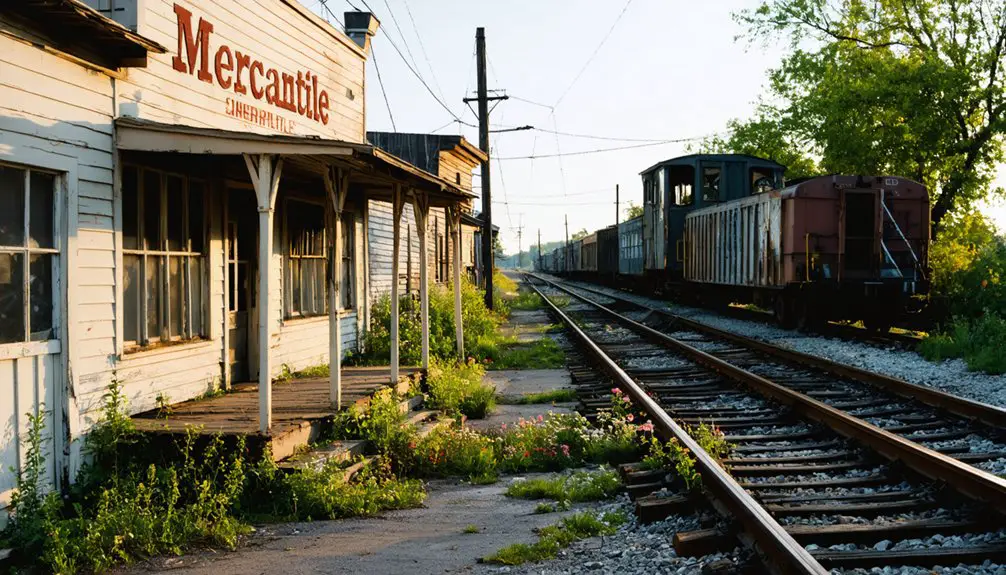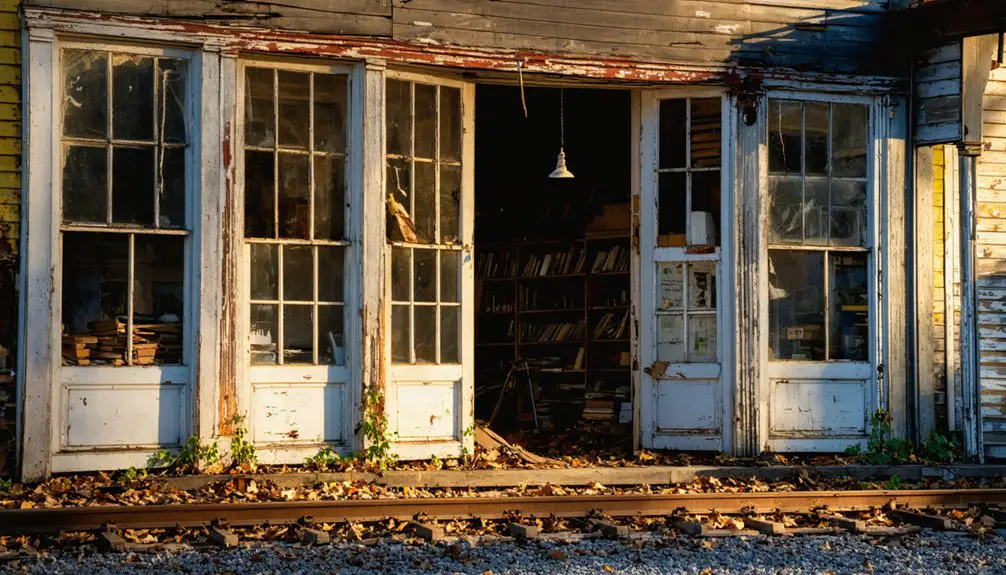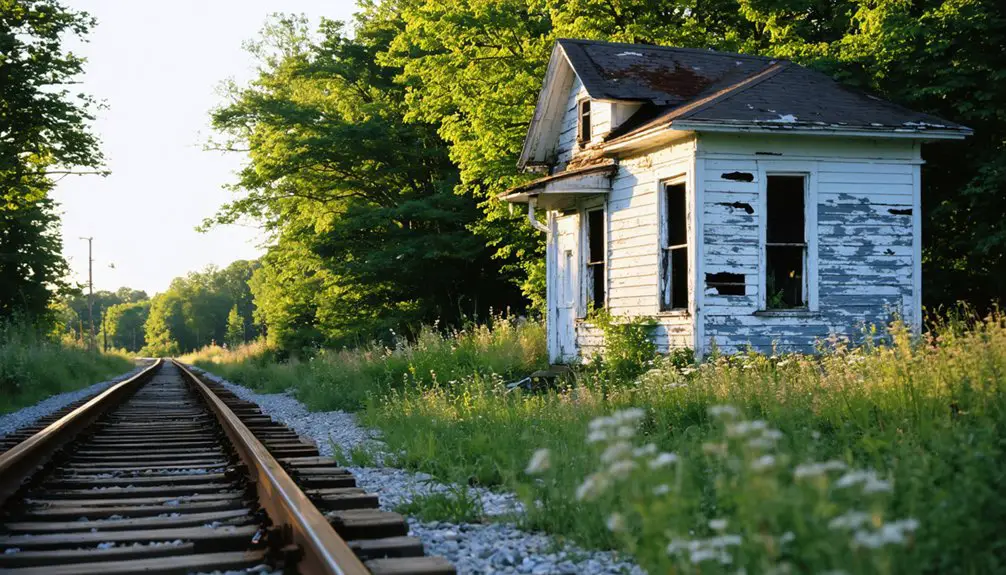You’ll find Westminster Station, Vermont along the Connecticut River as a ghost town showcasing Vermont’s 1850s railroad heritage. The Boston and Maine Railroad established it as a strategic transportation hub, with Gothic-style buildings and industrial warehouses marking its economic peak. Today, weathered structures and foundations hide among dense brush near Patch and Westminster West Roads, while archaeological surveys continue mapping historic sites. The station’s untold stories await between abandoned rail yards and crumbling architecture.
Key Takeaways
- Westminster Station transformed from a bustling railroad hub in the 1850s to a ghost town after the decline of rail transportation.
- Visitors can find abandoned warehouses, cellar holes, and foundations hidden among dense brush near Patch and Westminster West Roads.
- The Vermont Valley Creamery’s closure and Baxter Brothers Cannery fire in 1931 marked significant losses in the town’s industrial activity.
- While Amtrak trains pass through today, the once-thriving station no longer serves as a stop, symbolizing its ghost town status.
- Archaeological surveys document the remnants of this former transportation hub, with preservation efforts led by the Westminster Historical Society.
The Rise of Westminster Station as a Railroad Hub
When the railroad arrived in Westminster Station during the 1850s, it established a strategic depot on the Vermont side of the Westminster-Walpole bridge spanning the Connecticut River.
This railroad expansion transformed the riverside settlement into a crucial transportation hub, with rail lines running along both the Vermont and New Hampshire sides of the waterway.
You’ll find that Westminster Station’s position on the river plain proved ideal for the era’s transportation innovation. The depot’s location near the bridge created a perfect transfer point between states, enhancing regional connectivity.
Under the supervision of local figures like Hills, the Vermont Valley Railroad sections were constructed, establishing Westminster Station as a key junction in the growing rail network. The Boston and Maine Railroad would later become the primary operator of this important station.
The station’s strategic placement fueled its rise as an indispensable transportation center during the latter half of the 19th century.
Economic Glory Days Along the Connecticut River
You’ll find evidence of Westminster Station’s economic peak in the late 1800s when bustling river trade merged with newly established rail connections, creating a crucial transportation hub along the Connecticut River.
The Vermont Valley Creamery’s success from 1889 to 1914 exemplified the town’s industrial growth, shipping tons of butter to distant markets while the Abenaque Engine Company and chair factories hummed with activity. By 1771, the town had grown to include 478 residents, marking steady population growth that would support future commerce.
The Dutch trading post established at Hartford served as an early model for river commerce that Westminster Station would later emulate. Today’s abandoned warehouses and weathered industrial buildings along the riverbank stand as silent witnesses to Westminster Station’s former commercial prominence, when agricultural products and manufactured goods flowed freely between Vermont and broader New England markets.
River Trade Peak Years
During the late 19th and early 20th centuries, Westminster Station emerged as an essential economic hub along the Connecticut River, New England’s longest waterway.
You’d find bustling river commerce connecting Vermont and New Hampshire, with the strategic location facilitating trade between multiple states.
The area’s industrial growth peaked as manufacturing diversified. The Vermont Valley Creamery shipped tons of butter between 1889-1914, while the Abenaque Engine Company and a corn cannery expanded production. The town’s rich history dates back to its establishment as Township No. 1 in 1735.
You could spot various mills – grist, woolen, and sawmills – powered by Mill Brook and East Putney Brook, processing local agricultural materials.
The 1910 installation of a steel girder bridge, replacing earlier wooden structures, revolutionized transport efficiency.
This infrastructure improvement strengthened Westminster Station’s position as a crucial connection point for rail, river, and road transportation.
Railroad Junction Development
As regional railroad networks expanded across mid-19th century Vermont, Westminster Station emerged as a strategic railroad junction that would transform the village’s economic destiny.
Local leaders supervised the Vermont Valley Railroad’s construction around 1850, introducing revolutionary transportation innovations that would connect the community to distant markets.
You’ll find evidence of this railroad engineering feat in the village’s thoughtful layout, where Main Street runs parallel to both the rail line and Connecticut River.
Situated on a flat plain approximately 75 feet above river level, the village offered an optimal elevation for rail operations.
The village’s history is deeply intertwined with the Westminster Courthouse site, which predated the railroad era as a center of local governance.
The flat plain proved ideal for establishing a bustling transportation hub, with wood-framed Greek Revival, Gothic Revival, and Italianate buildings positioned to maximize rail access.
The station’s establishment prompted a post office and numerous commercial enterprises, creating a crucial multi-modal link between river barges and inland rail distribution networks.
Abandoned Warehouses Tell Stories
The weathered warehouses dotting Westminster Station’s riverside landscape tell the story of Vermont’s agricultural golden age.
You’ll find sliding board doors and ventilation slats that once kept apples fresh, while two-over-two sash windows reveal the buildings’ practical design. These warehouse stories showcase the Connecticut Valley Orchard‘s bustling operations, where 30 workers packed individually wrapped apples and maintained essential equipment.
The town’s early settlers established the area’s first mills in the 1730s, setting the foundation for future industrial growth. From 1889 to 1914, Vermont Valley Creamery‘s warehouse workers shipped tons of butter to city markets. The devastating Baxter Brothers Cannery fire in 1931 caused massive damage to the area’s industrial infrastructure.
Beyond commerce, these buildings demonstrated community resilience during crises – their workers and resources helped battle fires and floods.
Though global competition in the 1980s marked their decline, the abandoned structures stand as a symbol of Westminster’s economic height, when agriculture and manufacturing thrived along the Connecticut River.
Notable Buildings and Architecture
Westminster Station’s architectural legacy spans from the late 18th through early 20th centuries, showcasing a blend of Federal, Greek Revival, Gothic Revival, Italianate, Victorian eclectic, and Colonial Revival styles.
You’ll find the architectural significance lies in the village’s remarkable cohesion, achieved through consistent wooden construction, white clapboard siding, and slate roofs. Like much of Vermont, the buildings were constructed using local building materials including wood, limestone, and slate.
Most buildings feature vernacular forms with restrained ornamentation, unlike the flamboyant Victorian styles found elsewhere. The structures you’ll see evolved from simple beginnings – often bark shelters or log cabins – into more sophisticated frame houses. The area’s paper-making industry influenced the development and expansion of local architecture during the late nineteenth century.
Historical preservation efforts focus on maintaining original features like symmetrical facades, pedimented doorways, and paneled interiors.
Public buildings, though few survive intact, displayed refined Georgian and Gothic Revival elements, while residential structures incorporated Carpenter Gothic details like steep roofs and decorative bargeboards.
The Railroad’s Impact on Local Commerce

Following the arrival of rail service, you’ll find Westminster Station transformed from a modest mill town into a vibrant commercial hub, marked by the simultaneous opening of its post office and railroad station.
Railroad innovations revolutionized local industry, enabling the Abenaque Engine Company, chair factory, and Vermont Valley Creamery to flourish through expanded market access.
The strategic placement of freight transportation along the New Hampshire side of the river created new commercial corridors, shifting business away from traditional water-powered mill sites.
You’ll see how this rail network empowered farmers to ship dairy products and crops directly to urban markets, while supporting the Community Feed Store and various manufacturing enterprises.
The Central Vermont Railroad’s freight services continued well into the 20th century, cementing Westminster’s position as a significant regional trade center.
Daily Life in Westminster Station’s Peak Era
You’d find Westminster Station bustling with activity as trains arrived multiple times daily, bringing goods and connecting local farmers and craftsmen to broader markets.
The station served as more than just a transportation hub – it functioned as a gathering place where residents exchanged news, collected mail, and conducted business at nearby shops and warehouses.
Community life flourished around this central point, with families regularly congregating for social events, town meetings, and trading opportunities that the railroad connection made possible.
Railroad Commerce Hub
During the late 19th century, the convergence of rail lines transformed Westminster Station into a bustling commerce hub, where daily life revolved around the rhythms of arriving and departing trains.
Railroad expansion created a crucial transfer point between Vermont and New Hampshire lines, with the depot strategically positioned to serve both sides.
You’d find the commerce evolution most evident in the concentration of industries that sprung up along the tracks.
The Vermont Valley Creamery shipped tons of butter, while nearby factories produced chairs, farm machinery, and engines.
Mills powered by local brooks flourished with newfound rail access to urban markets.
The post office at the station became central to business communications, and the area’s economic landscape shifted dramatically as Westminster Station evolved from rural outpost to thriving commercial center.
Community Social Activities
Life in Westminster Station centered around vibrant community gatherings, with the courthouse and meeting-house serving as focal points for civic engagement and social connection.
You’d find residents participating in militia assemblies, public debates, and religious services that structured weekly life. Social rituals included seasonal fairs, market days, and cooperative work sessions at local mills and workshops.
The community’s pulse beat strongest during gatherings at the carriage shop and sawmill, where skilled artisans exchanged news while working.
Local leaders like Dr. Reuben Jones and Capt. Azariah Wright organized resistance meetings during pre-Revolutionary tensions. Trading activities near the depot created natural meeting spots, while religious observances and educational groups strengthened community bonds through shared prayer, scripture study, and informal schooling.
Factors Leading to the Town’s Decline

The decline of Westminster Station stemmed from a complex web of early challenges that plagued its development. From the 1750s through the late 1760s, you’ll find that geopolitical tensions between colonial powers created an unstable environment for growth. Territorial disputes between New Hampshire and New York further complicated the town’s progression, leaving settlers uncertain about their future.
Political tensions and territorial conflicts between colonial powers stunted Westminster Station’s growth, leaving early settlers in a perpetual state of uncertainty.
Here’s what sealed Westminster Station’s fate:
- Continuous Native American resistance and the French and Indian War forced multiple evacuations.
- Limited economic potential due to geographic constraints and poor transportation routes.
- Post-Revolutionary War shifts drew resources and attention away from local development.
The town’s isolation and lack of significant infrastructure ultimately prevented it from competing with more accessible Vermont communities, leading to its eventual abandonment.
Remnants and Ruins Today
Modern visitors seeking Westminster Station’s original village must look carefully among dense brush and woodlands, where forgotten ruins have lain hidden for nearly a century.
You’ll find cellar holes and foundations near the junction of Patch and Westminster West Roads, though the 1935 construction of Butler’s Pantry Bridge has altered the historic landscape.
This hidden history gained renewed attention when local experts like Bob Haas, Randy Major, and archaeologist Chris Bergman mapped and documented the site.
Edwin Gorham’s late 19th-century paintings and collected photo albums provide essential visual references for identifying ruins.
While natural reclamation protects these remnants from vandalism, it also accelerates their decay.
The archaeological significance of these ruins offers valuable insights into early Vermont settlement patterns, though they remain largely unexplored by casual visitors.
Stories From Former Residents
Before Westminster Station’s decline, you’d find bustling daily life centered around the railway depot where manufacturing and shipping activities dominated the local economy.
Railroad workers and craftspeople kept the station running while nearby residents operated sawmills along the brook and built carriages to serve the transportation needs of the region.
Former residents often recalled how the station acted as the lifeblood of the community, connecting their agricultural products and manufactured goods to distant markets until operations gradually wound down.
Daily Life Before Abandonment
Life in Westminster during its peak settlement years centered around a bustling mix of agricultural, industrial, and civic activities that defined daily routines for its residents.
You’d find farmers working the fertile river plains while craftsmen operated bustling sawmills and carriage shops along the streams. The courthouse served as the heart of civic engagement, where you could witness heated political debates and community gatherings.
- Agricultural pursuits dominated family life, with households settling on prime farmland near the Connecticut River.
- Local industry thrived through sawmills and workshops, connecting you to regional trade networks.
- Daily commerce and social activities revolved around the courthouse area, where you’d experience everything from judicial proceedings to community organizing.
The railway’s arrival transformed daily routines, integrating Westminster’s residents into broader economic networks while maintaining their independent spirit.
Remembering The Railroad Era
Through oral histories and written accounts, former Westminster residents paint a vivid picture of how the Vermont Valley Railroad transformed their once-isolated community into a bustling transportation hub.
You’ll hear stories of the Vermont Valley Creamery shipping tons of butter annually between 1889-1914, and farmers finally accessing wider markets for their dairy products.
The railroad connections fundamentally changed daily rhythms, as Westminster’s station near the Connecticut River bridge became a dynamic meeting point.
Community transformations were evident in the way public buildings and businesses clustered around Main Street, drawn by the constant flow of travelers and goods.
Former residents remember the railway as their economic lifeline, enabling local factories to thrive and connecting them to a world beyond their previously secluded village.
Archaeological Findings and Preservation Efforts
Recent archaeological surveys have extensively mapped the historic sites of Westminster, creating a thorough locational inventory focused primarily on above-ground features.
Through archaeological preservation efforts and community engagement, you’ll find a fascinating progression of early settler structures, from basic bark shelters to frame houses with distinctive ells.
Key archaeological discoveries include:
- Well-preserved foundations revealing the evolution of building techniques
- Surface artifacts indicating changes in domestic architecture
- Strategic settlement patterns influenced by the area’s unique geological features
The town’s archaeological heritage sits on flat plains bordered by steep wooded bluffs, with clay beds and marl deposits affecting soil preservation.
You’ll notice the Westminster Historical Society’s dedication to sharing these findings while respecting private property rights through strict landowner permission policies.
Legacy in Vermont’s Transportation History
As a pivotal transfer point along the Connecticut River, Westminster Station transformed regional commerce and connectivity during the 19th century by linking Vermont and New Hampshire’s expanding rail networks.
The station’s transportation infrastructure spurred industrial growth, enabling rapid shipment of chairs, farm machinery, and dairy products from local manufacturers like Vermont Valley Creamery.
You’ll find Westminster Station’s historic significance deeply rooted in its strategic geography. Built on a flat alluvial plain with access to both states’ rail lines, it became a crucial hub for cross-border trade.
While Amtrak’s Vermonter line now passes through without stopping, the station’s legacy lives on through the region’s preserved cultural sites and continued role as a transit node, marked by the intersection of Interstate 91 and major routes that still define Westminster’s character today.
Frequently Asked Questions
Were There Any Documented Ghost Sightings in Westminster Station?
You won’t find any documented ghost encounters or haunting legends for this location, as research shows no official records, eyewitness accounts, or paranormal investigations confirming supernatural activity there.
What Native American Tribes Originally Inhabited the Westminster Station Area?
Standing along the fertile Connecticut River valley, you’ll find the ancestral lands of the Western Abenaki peoples, particularly the Sokoki tribe, whose Indigenous history and Abenaki culture flourished here before European settlement.
How Did Westminster Station Residents Cope During Major Natural Disasters?
You’ll find residents relied on community resilience through militia organization, shared resources, and disaster preparedness. They used local terrain knowledge, family networks, and sturdy buildings to overcome environmental challenges together.
What Popular Entertainment Venues Existed in Westminster Station Before Abandonment?
You’d find entertainment at historic taverns, meetinghouses, and crossroad gathering spots. Local baseball games, theatrical performances, and town fairs brought the community together before formal theaters were established.
Did Any Famous Historical Figures Ever Visit Westminster Station?
Though millions wondered about historical visitors, you won’t find records of famous figures making notable journeys to Westminster Station. Local militia, settlers, and regional officials were the main documented visitors there.
References
- https://vtarchaeology.org/wp-content/uploads/VAS_Vol15_HaasEtal.pdf
- https://archive.org/stream/historyofwestmin00simo/historyofwestmin00simo_djvu.txt
- https://en.wikipedia.org/wiki/Westminster_(town)
- https://www.westminstervthistory.org
- https://www.crjc.org/heritage/V05-13.htm
- https://www.loc.gov/resource/hhh.nh0198.photos/?sp=18
- https://www.nashuacitystation.org/station/vermont/windham/westminster/westminster/
- https://en.wikipedia.org/wiki/Connecticut_River
- https://vermonthistory.org/westminster-courthouse
- https://vermontgenealogy.com/statewide/massacre_at_westminster_vermont.htm



